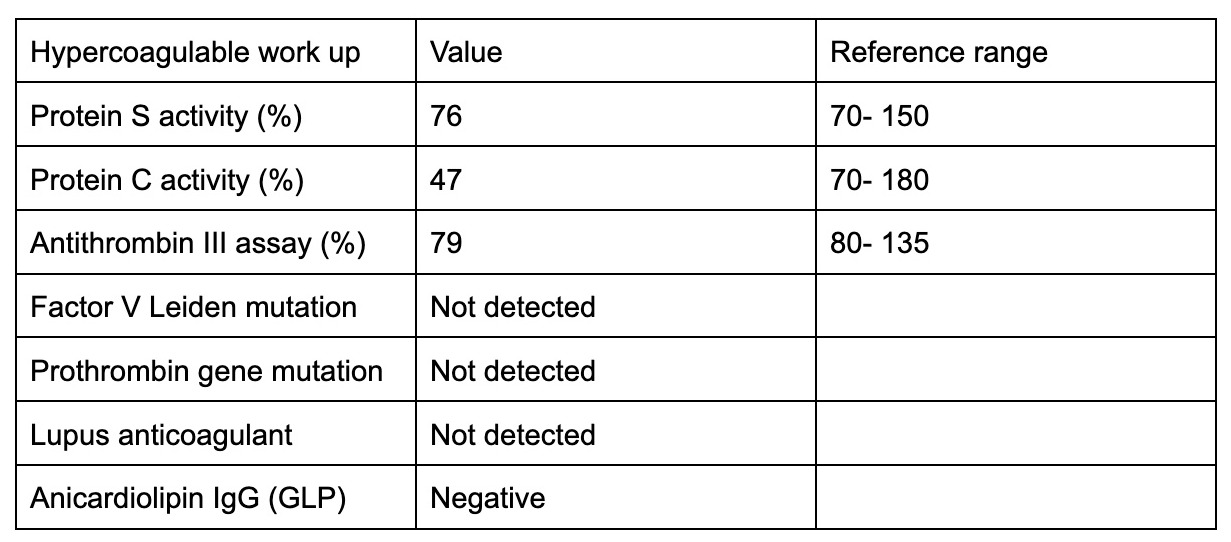Back
Poster Session C - Monday Afternoon
Category: Liver
C0614 - Budd-Chiari Syndrome as the Sole Presentation of SARS-CoV-2 Infection
Monday, October 24, 2022
3:00 PM – 5:00 PM ET
Location: Crown Ballroom

Charmee Vyas, MBBS
Monmouth Medical Center
Long Branch, NJ
Presenting Author(s)
Charmee Vyas, MBBS1, Ahmad Al-Alwan, MD1, Gaurav Mohan, MBBS1, Husam Bader, MD2
1Monmouth Medical Center, Long Branch, NJ; 2Monmouth Medical Center, Eatontown, NJ
Introduction: The SARS-CoV-2 infection has been associated with a significant risk of venous thromboembolism. We present a case of a 22-year-old man with no prior medical history who is diagnosed with Budd-Chiari syndrome due to SARS-CoV-2 infection.
Case Description/Methods: The patient had one month of dry cough and abdominal distention. He had worsening abdominal discomfort, dyspnea, orthopnea, and decreased urine output for a week prior to admission. At admission, the patient was in distress due to abdominal discomfort. He was hemodynamically stable, icteric, and pale, had a distended abdomen that was dull on percussion and had a fluid thrill with shifting dullness. His labs showed a picture of liver failure with INR 1.9 HI (0.9-1.1 HI), total bilirubin 2.8 mg/dl (0.2-1.2 mg/dl), albumin 3.3 g/dl (3.5-5.0 g/dl), ammonia 55 mcmol/l (11-32 mcmol/l), AST 94 U/L (10-43 U/L), ALT 58 U/L (13-41 U/L), and Alk Phos 264U/L (42-119 U/L). CBC, and CMP were normal. His SARS-CoV-2 reverse transcription-polymerase chain reaction (RT/PCR) was negative and the SARS-CoV-2 IgG antibody was positive. Inflammatory markers were elevated. Imaging of the abdomen showed a 10 cm mass-like area in the left hepatic lobe suspicious of hepatic malignancy versus altered vascularity and edema, thrombosis of all the hepatic veins, left portal vein, marked portal hypertension, liver failure, abdominal pelvic varices, and severe ascites. These findings were consistent with Budd Chiari Syndrome. A hypercoagulability workup was done as mentioned in the table. He underwent paracentesis three times during his hospital stay and underwent a liver mass biopsy for a definitive diagnosis. Biopsy showed bridging necrosis, central hepatic vein thrombosis, and congestion, negative for malignancy. The patient’s hypercoagulability, malignancy, and autoimmune workup were negative. Other tests like hepatitis panel, and HIV were negative. It was concluded that the Budd Chiari syndrome was due to mildly symptomatic SARS-CoV-2 infection. The patient was discharged on diuretics and was asked to follow up at a liver transplant center.
Discussion: Budd-Chiari syndrome is an unusual and sometimes the sole manifestation of SARS-CoV-2 infection. These patients might have no or minimal respiratory symptoms and usually have no underlying liver disease. The usual workup should involve ruling out hypercoagulable state, malignancy, and autoimmune disorder. Unfortunately, it can be fatal and a liver transplant is the only definitive management for such patients.

Disclosures:
Charmee Vyas, MBBS1, Ahmad Al-Alwan, MD1, Gaurav Mohan, MBBS1, Husam Bader, MD2. C0614 - Budd-Chiari Syndrome as the Sole Presentation of SARS-CoV-2 Infection, ACG 2022 Annual Scientific Meeting Abstracts. Charlotte, NC: American College of Gastroenterology.
1Monmouth Medical Center, Long Branch, NJ; 2Monmouth Medical Center, Eatontown, NJ
Introduction: The SARS-CoV-2 infection has been associated with a significant risk of venous thromboembolism. We present a case of a 22-year-old man with no prior medical history who is diagnosed with Budd-Chiari syndrome due to SARS-CoV-2 infection.
Case Description/Methods: The patient had one month of dry cough and abdominal distention. He had worsening abdominal discomfort, dyspnea, orthopnea, and decreased urine output for a week prior to admission. At admission, the patient was in distress due to abdominal discomfort. He was hemodynamically stable, icteric, and pale, had a distended abdomen that was dull on percussion and had a fluid thrill with shifting dullness. His labs showed a picture of liver failure with INR 1.9 HI (0.9-1.1 HI), total bilirubin 2.8 mg/dl (0.2-1.2 mg/dl), albumin 3.3 g/dl (3.5-5.0 g/dl), ammonia 55 mcmol/l (11-32 mcmol/l), AST 94 U/L (10-43 U/L), ALT 58 U/L (13-41 U/L), and Alk Phos 264U/L (42-119 U/L). CBC, and CMP were normal. His SARS-CoV-2 reverse transcription-polymerase chain reaction (RT/PCR) was negative and the SARS-CoV-2 IgG antibody was positive. Inflammatory markers were elevated. Imaging of the abdomen showed a 10 cm mass-like area in the left hepatic lobe suspicious of hepatic malignancy versus altered vascularity and edema, thrombosis of all the hepatic veins, left portal vein, marked portal hypertension, liver failure, abdominal pelvic varices, and severe ascites. These findings were consistent with Budd Chiari Syndrome. A hypercoagulability workup was done as mentioned in the table. He underwent paracentesis three times during his hospital stay and underwent a liver mass biopsy for a definitive diagnosis. Biopsy showed bridging necrosis, central hepatic vein thrombosis, and congestion, negative for malignancy. The patient’s hypercoagulability, malignancy, and autoimmune workup were negative. Other tests like hepatitis panel, and HIV were negative. It was concluded that the Budd Chiari syndrome was due to mildly symptomatic SARS-CoV-2 infection. The patient was discharged on diuretics and was asked to follow up at a liver transplant center.
Discussion: Budd-Chiari syndrome is an unusual and sometimes the sole manifestation of SARS-CoV-2 infection. These patients might have no or minimal respiratory symptoms and usually have no underlying liver disease. The usual workup should involve ruling out hypercoagulable state, malignancy, and autoimmune disorder. Unfortunately, it can be fatal and a liver transplant is the only definitive management for such patients.

Figure: Anticoagulation workup
Disclosures:
Charmee Vyas indicated no relevant financial relationships.
Ahmad Al-Alwan indicated no relevant financial relationships.
Gaurav Mohan indicated no relevant financial relationships.
Husam Bader indicated no relevant financial relationships.
Charmee Vyas, MBBS1, Ahmad Al-Alwan, MD1, Gaurav Mohan, MBBS1, Husam Bader, MD2. C0614 - Budd-Chiari Syndrome as the Sole Presentation of SARS-CoV-2 Infection, ACG 2022 Annual Scientific Meeting Abstracts. Charlotte, NC: American College of Gastroenterology.
